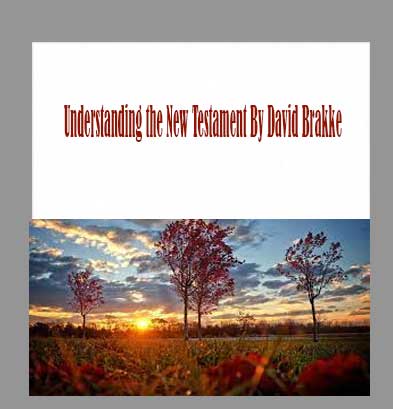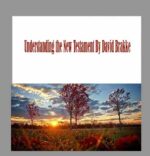Description
David Brakke – Understanding the New Testament download, David Brakke – Understanding the New Testament review, David Brakke – Understanding the New Testament free
David Brakke – Understanding the New Testament
Understanding the New Testament
Join a historian to look at the New Testament with a new eye as you gain powerful insights into this influential series of books of the Bible.
LECTURE (24)
01:The Paradox of the New Testament
The New Testament is comprised of 27 books by more than a dozen authors, yet it is also presented as a single, unified text. How do you resolve the paradox of one book versus many? In this opening lecture, see how historians view the New Testament and why they are excited by its diversity of voices.
02:The Jewish Origins of Christian Faith
Before delving into the New Testament, you first must look at ancient Judaism for context about the birth of Christianity. Here, explore key stories and themes of the Old Testament—including God’s covenants with Abraham, Moses, and David, as well as Jewish eschatology—to understand the world of Jesus of Nazareth.
03:1 Thessalonians and Paul’s Ministry
The New Testament includes many types of narrative, among them gospels, epistles, and revelations. In this first lecture on Paul’s epistles, you will reflect on the chronologically earliest book of the New Testament. Examine the structure of a Pauline letter, and find out what his mission of evangelism was all about.
04:The Salvation of Gentiles in Galatians
Continue your study of Paul’s epistles with a detailed look at his letter to the Galatians. In it, he offers a scathing rebuke to a congregation he believes has backslid after his departure. Find out why he believed it was so important to establish faith in Jesus as the one and only quality that gets you into heaven.
05:Romans on God, Faith, and Israel
Paul’s letter to the Romans is his theological masterpiece. Because he had never been to Rome, he wrote this letter to introduce himself and his teachings to lay the groundwork for his arrival. Unpack the key message of his theology—namely, that one is made righteous solely through faith in Jesus Christ.
06:Community Conflicts in 1–2 Corinthians
In this first of two lectures about Paul’s letters to the Corinthians, you will consider one tension inherent to Christian congregations. In Paul’s theology, everyone is equal in the eyes of the Lord, yet Corinth was a prosperous and diverse city. How did Paul reconcile economic, intellectual, and educational diversity with religious unity?
07:Worship and Leaders in Paul’s Congregations
The two letters to the Corinthians give us great insight into Paul’s theology, but they also provide interesting historical evidence for how early Christian congregations operated. How did believers worship? Who were the church leaders? What were the roles for men and women? Find out what the letters tell us about the community.
08:Paul’s Theology on Slavery and Christ
Although Paul’s letters to Philemon and to the Philippians are very different, they have two important things in common. Paul wrote them both from prison, and they each concern slavery. Gain insight into Paul’s views around imprisonment, as well as his ideas about Christ’s humanity and divinity.
09:Adapting Paul’s Teachings to New Situations
Not all of Paul’s letters were composed by the apostle himself. The three “Deutero-Pauline†letters (2 Thessalonians, Colossians, and Ephesians) likely date to the years after Paul’s death. In content, they seek to reassure readers that a series of events must occur before the end times arrive and that faith in Christ is all that is necessary for salvation in the present.
10:Jesus as the Suffering Son of Man in Mark
Shift your attention from Paul’s epistles to the gospels, starting with the Gospel According to Mark. After reviewing what historians know about the author and the book’s composition, Professor Brakke surveys the time of Jesus’ ministry and death and explicates the key themes of Mark’s gospel.
11:Jesus as the New Moses in Matthew
The unknown Christian who wrote the gospel now called Matthew presents a different theological portrait of Jesus and his ministry than Mark. Whereas Jesus in Mark is a mysterious figure, Matthew emphasizes Jesus’ divinity. In this lecture, compare the two gospels and what scholars believe about their composition.
12:The Church in the Gospel of Matthew
Continue your study of the Gospel of Matthew, which gives us the only mention of the word “church†in all of the four gospels. Consider Matthew’s interest in forming and leading the church, and reflect on the conflict, in Matthew, between the Jesus who teaches Jewish law and the Jesus who critiques Jewish leaders.
13:Luke and Acts on God’s History of Salvation
The Gospel of Luke is the first book in a two-volume work, the second being the book of Acts. Luke presents himself as a historian, so consider the two-volume Luke-Acts as a historical work. Who were Luke’s sources? What story does he want to tell? How and why does his story unfold?
14:Luke’s Inclusive Message
The grand narrative in the books Luke through Acts spans 60 years and presents a unified narrative of early Christian history. In this second lecture on Luke, look at the people and parables presented in his history—particularly the women, both named and anonymous, he writes about. Encounter a truly expansive, inclusive vision for Christianity.
15:The Apostles and Church in Luke and Acts
Because Luke was writing as a historian, probably between the years A.D. 90 and A.D. 120, he didn’t merely re-create the past. Rather, Luke has a perspective on the history he tells. Unpack his vision of early Christian history and consider what message he is sending to his readers. Compare that message to the earlier “Gospel according to Mark.â€
16:Jesus as the Divine Word in John
The “Gospel according to John†is an anomaly, set apart from the other three “Synoptic Gospels.†Although the basic story of Jesus remains the same, running from the ministry of John the Baptist to the death and resurrection of Jesus, John’s gospel contains more philosophy and has been called a more “spiritual†gospel.
17:Jesus and the Jews in the Gospel of John
In addition to its spiritual philosophy, the Gospel of John also contains troubling rhetoric around Jews and Judaism. Investigate the reasons behind John’s depiction of the Jews and why it is so negative. See why John’s portrayal of Jesus has made this gospel both an object of theological controversy and a source of deep spirituality.
18:The Community of John after the Gospel
What happened when an early Christian community began to fall apart? Disagreements over theology, challenges to church leadership, or disintegration of the group altogether were common, and the letters of John tackle these problems head-on. Delve into early efforts to unify a fractured church.
19:In Search of the Historical Jesus
The “Historical Jesus†refers to the man named Jesus of Nazareth as opposed to the Christ we find in the gospels—a challenge for historians given that the gospels are our primary sources. Trace the development of biblical scholarship and research after the Renaissance and Enlightenment, when scholars began to think critically about the man named Jesus.
20:Interpreting Abraham in Hebrews and James
You might think of Abraham as belonging to the Old Testament, but he plays a mighty role in the writings of the New Testament. In the book of Hebrews, Abraham appears as a model of faith, whereas, in James he is an object of controversy over how people are saved—by faith alone or by faith and works.
21:Churches in Crisis in 1–2 Peter and Jude
Along with James and the three letters of John, 1-2 Peter and Jude are known as the “catholic†or general epistles because they are addressed to multiple congregations, or Christians, in general. See what these most recent books of the New Testament tell us about a mature and growing religious movement.
22:New Leaders in the Pastoral Epistles
Paul’s first and second letters to Timothy and the letter to Titus form a special group of epistles because they were written not to congregations but to church pastors, offering advice for how individual leaders ought to conduct themselves and guide their congregations. Together, they help us explore the development of an independent, organized religion.
23:Revelation: Envisioning God’s Reality
The book of Revelation presents a complex; symbolic; and, at times, even bizarre vision of the present day and the future. In this lecture, Professor Brakke outlines why the Romans persecuted the Christians before turning to the content of Christ’s revelation to John. Dive into this fascinating, challenging book.
24:The Quest for Unity in the New Testament
In this final lecture, revisit the paradox between the New Testament’s diversity and unity, a single text comprised of 27 different books. See how theologians and scholars over the years have tackled this paradox. Examples include the Christian leaders Irenaeus, Origen, and Martin Luther, as well as modern historical researchers.
DETAILS
Overview
In these 24 eye-opening episodes, Professor David Brakke takes you behind the scenes to study not only the text of the New Testament, but also the authors and the world in which it was created. You’ll explore Jewish lives under Roman occupation, reflect on the apocalyptic mood of the first and second centuries AD, and witness the early Christians’ evangelism beyond the Jewish communities.
Â
About
David Brakke
What the people we will study would want us to do is to read their texts, to consider with open minds what they teach us, and-just possibly-to pursue our own quests for the truth about God and ourselves-that is, to seek our own gnosis.Â
ALMA MATER
Yale University
INSTITUTION
The Ohio State University
Professor David Brakke is the Joe R. Engle Chair in the History of Christianity and Professor of History at The Ohio State University. He received his B.A. in English from the University of Virginia, his M.Div. from Harvard Divinity School, and his Ph.D. in Religious Studies from Yale University. He taught for 19 years in the Department of Religious Studies at Indiana University.
Professor Brakke has published extensively on the history and literature of ancient Christianity, especially Egyptian Christianity, early monasticism, the formation of the biblical canon, and Gnosticism. His books include The Gnostics: Myth, Ritual, and Diversity in Early Christianity; Demons and the Making of the Monk: Spiritual Combat in Early Christianity; and Introduction to Christianity, with Mary Jo Weaver. He has co-edited six volumes of scholarly essays and contributed nearly 40 articles to professional journals and volumes. From 2005 to 2015, he served as editor of the Journal of Early Christian Studies.
At Indiana University, Professor Brakke received recognition for his teaching and research, including the Outstanding Junior Faculty Award. He has held several important fellowships, including ones from the National Endowment for the Humanities and the Alexander von Humboldt Foundation. He is currently preparing a revised edition of Bentley Layton’s The Gnostic Scriptures.







